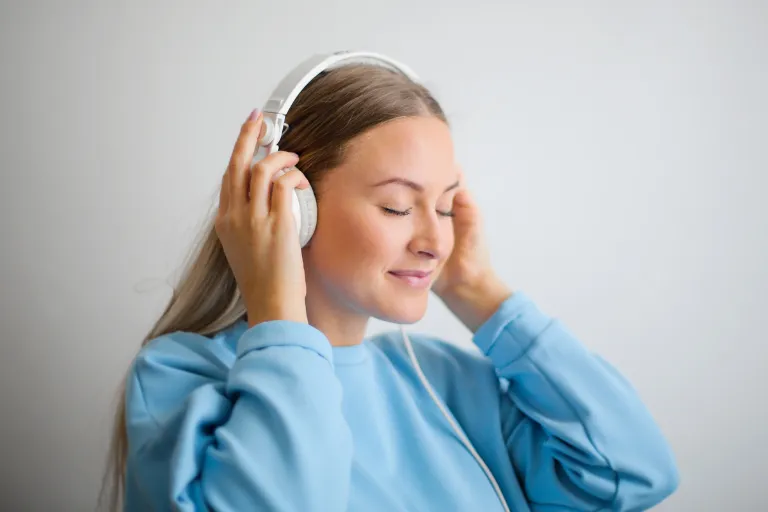Key Points
- Music affects brain circuits tied to mood, stress, and reward—even small listening habits can shift emotional tone.
- Scientific reviews and meta-analyses show music therapy is associated with reduced anxious thoughts, improved emotional resilience, and lower stress biomarkers.
- There are multiple modes of music therapy (receptive, active, improvisational, neurologic) tailored to different needs.
- Everyday practices—playlists, singing, mindful listening—can supplement professional care.
- Emerging technologies (AI curation, wearable feedback) are expanding access to personalized music therapy.
A Note in the Mind: How Music Opens the Door to Emotional Change
It’s late afternoon. You slip on headphones, hit “play,” and the next thing you know your body softens, tension loosens, and your mind drifts somewhere kinder. What’s at work here is more than habit—it’s biology.
In recent years, music therapy has moved from the fringes of wellness into medical and psychological settings. The reason: data. Researchers now map how melody, rhythm, and harmony ripple through brain circuitry and physiology, making music a serious tool for mood regulation.
Why Mood Balance Matters—and Why Music Therapy Is Rising
People everywhere are under more pressure—digital overload, economic stress, isolation, nonstop news cycles. Many seek solutions that feel gentle, natural, and low risk.
Music therapy fits that niche. It’s low-cost, accessible, and adaptable. Hospitals, rehab centers, schools, and mental health clinics now often incorporate it into treatment plans. A 2025 systematic review found robust reductions in anxiety when certified music therapists delivered interventions across diverse settings [1]. Another meta-analysis of 47 studies showed a medium-to-large effect size (d ≈ 0.72) on stress outcomes when music therapy was used versus control conditions [2].
Beyond mood alone, a recent trial involving 256 participants over 8 weeks showed that music therapy significantly enhanced emotional resilience, which in turn improved overall well-being and employment outcomes [3].
In short: music therapy is not a replacement for conventional care—but the evidence suggests it can be a meaningful adjunct for mood support.
Signs You Could Benefit: Emotional Imbalance in Daily Life
Mood dysregulation doesn’t always show up as full-blown depressive states or crisis. It often arrives more subtly:
- Persistent tension, restlessness, or agitated thoughts
- Difficulty calming the mind or “turning off” at night
- Emotional swings—feeling overly irritable one moment, numb the next
- Craving quiet but feeling unsettled in silence
- Relying on external crutches (caffeine, screen time, avoidance) to mask inner discomfort
These are early flags—not necessarily pathology, but signals the emotional system is out of balance. Music therapy can help re-tune that system rather than masking it.
From Sound to Synapse: The Neuroscience of Music and Mood
How does music reach deep into our emotional core? Below are key mechanisms supported by current research:
1. Reward circuits and dopamine release
Listening to or anticipating favorite music activates the ventral striatum and nucleus accumbens, triggering dopamine release—a neurotransmitter tied to pleasure and motivation [4]. This reward response is one reason music feels “good” almost immediately.
2. Modulation of the autonomic nervous system
Slower tempos and calming harmonies can promote parasympathetic (“rest-and-digest”) activity, lowering heart rate and cortisol. A randomized trial in patients with minimal consciousness even showed changes in autonomic measures and brain network connectivity linked to musical stimulation [5].
3. Vagal activation and body-mind tuning
Some researchers propose that music stimulates afferent signals from the ear through the vagus nerve—thereby nudging the body toward calm states [6]. Though mechanistic studies are ongoing, this idea is gaining traction in integrative therapies.
4. Network plasticity, prefrontal control & emotional regulation
Music therapy is thought to strengthen connections within the prefrontal cortex–hippocampus–amygdala circuit, enhancing top-down regulation of emotion [7]. In other words: the parts of your brain that weigh “how I feel” with “what to do next” get reinforced.
5. Molecular and neurochemical modulation
Emerging models suggest music influences monoamines, glutamate systems, inflammatory cytokines, and even mitochondrial and microRNA pathways [7]. While speculative, this helps frame music as a multi-level regulator—not just a mood trick.
Taken together, these mechanisms show that music is far more than background noise—it’s a biologically active input.
Tailored Techniques: What Happens in Music Therapy
“Music therapy” is not one-size-fits-all. Trained music therapists match technique to emotional goals, cognitive needs, and sensory preferences. Key forms include:
- Receptive Therapy – The user listens to curated tracks to evoke emotional processing or relaxation.
- Active Therapy – The user sings, plays, or drums along to express internal states externally.
- Improvisational Methods – The therapist and user improvise in the moment, fostering creativity, spontaneity, and release.
- Neurologic Music Therapy – Uses structured rhythm and sensory cues to support attention, speech, and motor function, often employed in neurological rehabilitation [3,8].
Each modality leverages different neural pathways and modes of engagement. A user in emotional distress might respond best to receptive work first; someone seeking more agency might shift toward active or improvisational phases.
How to Use Music as a Mood Tool (Outside the Clinic)
You don’t need training to begin reaping small benefits. Here are evidence-informed strategies:
- Curated Intentional Listening
Pick a short “mood shift” playlist (6–8 songs) for transitions—morning, midday slump, evening unwind. - Expressive Singing or Humming
Vocalizing—even quietly—can engage the vagus pathway and anchor you in sensation rather than thought. - Intermittent Mindful Listening
Spend 5–10 minutes focusing entirely on one track: follow its rhythm, notice instrumentation, track emotional ups and downs. - Rhythmic Anchoring
Use tapping or light percussion (e.g. tapping on tabletop) to match the music’s pulse. This can ground dysregulated energy. - Guided Apps & Playlists
Some mobile apps now tailor music selection based on mood, physiological input, or emotional prompts—essentially blending AI with therapeutic design [9].
Over time, these habits can help your nervous system flexibly shift between states—less stuck in high alert or shutdown.
When to Explore Professional Music Therapy
Self-use is useful but has limits. Professional music therapy may be especially helpful when:
- Emotional dysregulation feels chronic or severe
- You have co-occurring trauma, cognitive changes, or physical disability
- You want ongoing, measurable support and progression
- You’re using music therapy alongside other psychological therapies
Certified therapists can design a phased program, monitor your response, and adapt technique as you evolve. To find one, check with the American Music Therapy Association (AMTA) or regional associations.
Envisioning the Future: Tech, Access, and Personalization
The frontier of music therapy lies in personalization. AI tools like EmoHeal now map subtle emotional states to musical parameters, crafting playlists meant to guide you toward calmer affective zones [9]. Meanwhile, wearable devices may soon detect physiological signals (heart rate variability, skin conductance) to dynamically adapt music in real time.
These developments hint at a future where music therapy isn’t limited to appointments—it meets you in your daily life, automatically and responsively.
Conclusion: Inviting Music Back into Your Emotional Ecosystem
It’s tempting to regard music as ambient or decorative. But between notes lies power—that of biology, regulation, and renewal. When used with purpose, music therapy can help harmonize your internal world.
If your mind feels like static noise, try this: listen not for distraction or escape, but with intention. Track what feels different afterward. Seek guidance if deeper work is needed. With time, your brain, body, and emotions may all find more balance—and the simple act of listening can become a tool for healing.
The article does not in any way constitute as medical advice. Please seek consultation with a licensed medical professional before starting any treatment. This website may receive commissions from the links or products mentioned in this article.
Subscribe for Free for more insightful health articles tailored to your needs.
Sources
- “Music therapy for the treatment of anxiety: a systematic review with meta-analysis.” eClinicalMedicine / The Lancet (2025).
Link: https://www.thelancet.com/journals/eclinm/article/PIIS2589-5370%2825%2900225-1/fulltext - de Witte, M., da Silva Pinho, A., et al. (2020). Music therapy for stress reduction: a systematic review and meta-analysis. Health Psychology Review.
doi:10.1080/17437199.2020.1846580 - Feng, Y. & Wang, M. (2025). Effect of music therapy on emotional resilience, well-being, and employability: a quantitative investigation of mediation and moderation. BMC Psychology, 13, 47.
Link: https://bmcpsychology.biomedcentral.com/articles/10.1186/s40359-024-02336-x - “Music and Dopamine – Potential in Movement Disorders.” Science Repository.
Link: https://www.sciencerepository.org/music-and-dopamine_JBN-2020-1-102 - Xiao, X., Chen, W., Zhang, X., et al. (2023). The effect and mechanisms of music therapy on the autonomic nervous system and brain networks of patients with minimal conscious state. Frontiers in Neuroscience.
Link: https://www.frontiersin.org/articles/10.3389/fnins.2023.1182181/full - “The effect of music and vagus nerve to improve various diseases.” PJMH Online.
Link: https://pjmhsonline.com/2021/june/1854.pdf - “Potential common targets of music therapy intervention in human neuroscience.” Frontiers in Human Neuroscience (2025).
Link: https://www.frontiersin.org/journals/human-neuroscience/articles/10.3389/fnhum.2025.1471433/full - “Why is music therapeutic for neurological disorders? The Therapeutic Music Capacities Model.” ScienceDirect.
Link: https://www.sciencedirect.com/science/article/pii/S014976341930243X - Wan, X., Liang, J., Zhang, H. (2025). EmoHeal: An End-to-End System for Personalized Therapeutic Music Retrieval from Fine-grained Emotions. Preprint, arXiv.
Link: https://arxiv.org/abs/2509.15986




